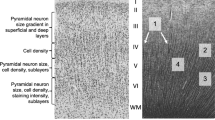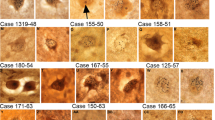Abstract
The human cerebral cortex and cerebellum are greatly expanded compared to those of other mammals, including the great apes. This expansion is reflected in differences in the size and organization of precerebellar brainstem structures, such as the inferior olive. In addition, there are cell groups unique to the human brainstem. One such group may be the nucleus pararaphales (PRa); however, there is disagreement among authors about the size and location of this nucleus in the human brainstem. The name “pararaphales” has also been used for neurons in the medulla shown to project to the flocculus in the macaque monkey. We have re-examined the existence and status of the PRa in eight humans, three chimpanzees, and four macaque monkeys using Nissl-stained sections as well as immunohistochemistry. In the human we found a cell group along the midline of the medulla in all cases; it had the form of interrupted cell columns and was variable among cases in rostrocaudal and dorsoventral extent. Cells and processes were highly immunoreactive for non-phosphorylated neurofilament protein (NPNFP); somata were immunoreactive to the synthetic enzyme for nitric oxide, nitric oxide synthase, and for calretinin. In macaque monkey, there was a much smaller oval cell group with NPNFP immunoreactivity. In the chimpanzee, we found a region of NPNFP-immunoreactive cells and fibers similar to what was observed in macaques. These results suggest that the “PRa” in the human may not be the same structure as the flocculus-projecting cell group described in the macaque. The PRa, like the arcuate nucleus, therefore may be unique to humans.








Similar content being viewed by others
References
Atlas SW, Grossman RI, Savino PJ, Schatz NJ, Sergott RC, Bosley TM, Hackney DB, Goldberg HI, Bilaniuk LT, Zimmerman RA (1987) Internuclear ophthalmoplegia: MR-anatomic correlation. Am J Neuroradiol 8(2):243–247
Baizer JS (2009) Nonphosphorylated neurofilament protein is expressed by scattered neurons in the vestibular and precerebellar brainstem. Brain Res 1298:46–56
Baizer JS, Baker JF (2005) Immunoreactivity for calcium-binding proteins defines subregions of the vestibular nuclear complex of the cat. Exp Brain Res 164(1):78–91
Baizer JS, Baker JF (2006) Immunoreactivity for calretinin and calbindin in the vestibular nuclear complex of the monkey. Exp Brain Res 172(1):103–113
Baizer JS, Broussard DM (2010) Expression of calcium-binding proteins and nNOS in the human vestibular and precerebellar brainstem. J Comp Neurol 518(6):872–895
Baizer JS, Baker JF, Haas K, Lima R (2007) Neurochemical organization of the nucleus paramedianus dorsalis in the human. Brain Res 1176:45–52
Baizer JS, Paolone N, Kramer V, Sherwood C, Hof P (2010) Neurochemical organization of the chimpanzee vestibular brainstem. Soc Neurosci Abs 583.23/WW16
Baizer JS, Paolone NA, Witelson SF (2011a) Nonphosphorylated neurofilament protein is expressed by scattered neurons in the human vestibular brainstem. Brain Res 1382:45–56
Baizer JS, Sherwood CC, Hof PR, Witelson SF, Sultan F (2011b) Neurochemical and structural organization of the principal nucleus of the inferior olive in the human. Anat Rec 294(7):1198–1216
Barmack NH, Qian Z (2002) Activity-dependent expression of calbindin in rabbit floccular Purkinje cells modulated by optokinetic stimulation. Neuroscience 113(1):235–250
Berman A (1968) The brain stem of the cat. University of Wisconsin Press, Madison
Biondo B, Lavezzi A, Tosi D, Turconi P, Matturri L (2003) Delayed neuronal maturation of the medullary arcuate nucleus in sudden infant death syndrome. Acta Neuropathol 106(6):545–551
Blanks RH, Precht W (1983) Responses of units in the rat cerebellar flocculus during optokinetic and vestibular stimulation. Exp Brain Res 53(1):1–15
Büttner-Ennever JA, Horn AK (1996) Pathways from cell groups of the paramedian tracts to the floccular region. Ann N Y Acad Sci 781:532–540
Epema AH, Gerrits NM, Voogd J (1990) Secondary vestibulocerebellar projections to the flocculus and uvulo-nodular lobule of the rabbit: a study using HRP and double fluorescent tracer techniques. Exp Brain Res 80(1):72–82
Frohman EM, Frohman TC, Zee DS, McColl R, Galetta S (2005) The neuro-ophthalmology of multiple sclerosis. Lancet Neurol 4(2):111–121
Frohman TC, Galetta S, Fox R, Solomon D, Straumann D, Filippi M, Zee D, Frohman EM (2008) Pearls & Oy-sters: the medial longitudinal fasciculus in ocular motor physiology. Neurology 70(17):e57–e67
Fukasawa M, Okamoto K, Nakamura M, Mikami K, Shimada S, Tanaka Y, Nagai K, Arito M, Kurokawa MS, Masuko K, Suematsu N, Koizuka I, Kato T (2009) Proteomic analysis of the rat cerebellar flocculus during vestibular compensation. J Vestib Res 19(3–4):83–94
Fukushima K (1991) The interstitial nucleus of Cajal in the midbrain reticular formation and vertical eye movement. Neurosci Res 10(3):159–187
Fukushima K, Fukushima J (1992) The interstitial nucleus of Cajal is involved in generating downward fast eye movement in alert cats. Neurosci Res 15(4):299–303
Fukushima K, Harada C, Fukushima J, Suzuki Y (1990) Spatial properties of vertical eye movement-related neurons in the region of the interstitial nucleus of Cajal in awake cats. Exp Brain Res 79(1):25–42
Glickstein M, Waller J, Baizer JS, Brown B, Timmann D (2005) Cerebellum lesions and finger use. Cerebellum 4(3):189–197
Glickstein M, Sultan F, Voogd J (2011) Functional localization in the cerebellum. Cortex 47(1):59–80
Johnston AR, Seckl JR, Dutia MB (2002) Role of the flocculus in mediating vestibular nucleus neuron plasticity during vestibular compensation in the rat. J Physiol 545(Pt 3):903–911
Karatas M (2009) Internuclear and supranuclear disorders of eye movements: clinical features and causes. Eur J Neurol 16(12):1265–1277
Klier EM, Wang H, Crawford JD (2007) Interstitial nucleus of cajal encodes three-dimensional head orientations in Fick-like coordinates. J Neurophysiol 97(1):604–617
Ksiezak-Reding H, Dickson DW, Davies P, Yen SH (1987) Recognition of tau epitopes by anti-neurofilament antibodies that bind to Alzheimer neurofibrillary tangles. Proc Natl Acad Sci USA 84(10):3410–3414
LaBossiere E, Glickstein M (1976) Histological processing for the neural sciences. Charles C Thomas, Springfield
Langer T, Fuchs AF, Scudder CA, Chubb MC (1985) Afferents to the flocculus of the cerebellum in the rhesus macaque as revealed by retrograde transport of horseradish peroxidase. J Comp Neurol 235(1):1–25
Lavezzi AM, Ottaviani G, Mauri M, Matturri L (2004) Hypoplasia of the arcuate nucleus and maternal smoking during pregnancy in sudden unexplained perinatal and infant death. Neuropathology 24(4):284–289
Lee VM, Otvos L Jr, Carden MJ, Hollosi M, Dietzschold B, Lazzarini RA (1988) Identification of the major multiphosphorylation site in mammalian neurofilaments. Proc Natl Acad Sci USA 85(6):1998–2002
Leigh R, Zee DS (2006) Synthesis of the command for conjugate eye movements. In: Leigh R, Zee DS (eds) The neurology of eye movements. Oxford University Press, Oxford
Lisberger SG, Fuchs AF (1978a) Role of primate flocculus during rapid behavioral modification of vestibuloocular reflex. I. Purkinje cell activity during visually guided horizontal smooth-pursuit eye movements and passive head rotation. J Neurophysiol 41(3):733–763
Lisberger SG, Fuchs AF (1978b) Role of primate flocculus during rapid behavioral modification of vestibuloocular reflex. II. Mossy fiber firing patterns during horizontal head rotation and eye movement. J Neurophysiol 41(3):764–777
Lisberger SG, Pavelko TA, Broussard DM (1994a) Neural basis for motor learning in the vestibuloocular reflex of primates. I. Changes in the responses of brain stem neurons. J Neurophysiol 72(2):928–953
Lisberger SG, Pavelko TA, Broussard DM (1994b) Responses during eye movements of brain stem neurons that receive monosynaptic inhibition from the flocculus and ventral paraflocculus in monkeys. J Neurophysiol 72(2):909–927
Matturri L, Ottaviani G, Alfonsi G, Crippa M, Rossi L, Lavezzi AM (2004) Study of the brainstem, particularly the arcuate nucleus, in sudden infant death syndrome (SIDS) and sudden intrauterine unexplained death (SIUD). Am J Forensic Med Pathol 25(1):44–48
Matturri L, Ottaviani G, Benedetti G, Agosta E, Lavezzi AM (2005) Unexpected perinatal death and sudden infant death syndrome (SIDS): anatomopathologic and legal aspects. Am J Forensic Med Pathol 26(2):155–160
Olszewski J, Baxter D (1954) Cytoarchitecture of the human brain stem, 2nd edn. Karger, Basel
Ottaviani G, Matturri L, Mingrone R, Lavezzi AM (2006) Hypoplasia and neuronal immaturity of the hypoglossal nucleus in sudden infant death. J Clin Pathol 59(5):497–500
Ottaviani G, Mingrone R, Lavezzi AM, Matturri L (2009) Infant and perinatal pulmonary hypoplasia frequently associated with brainstem hypodevelopment. Virchows Arch 454(4):451–456
Paxinos G, Huang XF (1995) Atlas of the human brainstem. Academic Press, San Diego
Paxinos G, Watson C (2005) The rat brain in stereotaxic coordinates, 5th edn. Elsevier Academic Press, Amsterdam
Paxinos G, Huang XF, Toga AW (2000) The rhesus monkey brain in stereotaxic coordinates. Academic Press, San Diego
Rambold H, Churchland A, Selig Y, Jasmin L, Lisberger SG (2002) Partial ablations of the flocculus and ventral paraflocculus in monkeys cause linked deficits in smooth pursuit eye movements and adaptive modification of the VOR. J Neurophysiol 87(2):912–924
Shu SY, Ju G, Fan LZ (1988) The glucose oxidase-DAB-nickel method in peroxidase histochemistry of the nervous system. Neurosci Lett 85(2):169–171
Sternberger LA, Sternberger NH (1983) Monoclonal antibodies distinguish phosphorylated and nonphosphorylated forms of neurofilaments in situ. Proc Natl Acad Sci USA 80(19):6126–6130
Sultan F, Glickstein M (2007) The cerebellum: comparative and animal studies. Cerebellum 6(3):168–176
Van der Gucht E, Youakim M, Arckens L, Hof PR, Baizer JS (2006) Variations in the structure of the prelunate gyrus in Old World monkeys. Anat Rec 288(7):753–775
Voogd J, Feirabend H, Schoen J (1990) Cerebellum and precerebellar nuclei. In: Paxinos G (ed) The Human Nervous System. Academic Press, San Diego
Weaver AH (2005) Reciprocal evolution of the cerebellum and neocortex in fossil humans. Proc Natl Acad Sci USA 102(10):3576–3580
Weinstock N, Hof P, Sherwood C, Witelson S, Baizer J (2011) The nucleus pararaphales in monkey, man and chimpanzee. Soc Neurosci Abs 183.08/QQ19
Witelson SF, McCulloch PB (1991) Premortem and postmortem measurement to study structure with function: a human brain collection. Schizophr Bull 17(4):583–591
Acknowledgments
Supported in part by the Department of Physiology and Biophysics, University at Buffalo and the James S. McDonnell Foundation, grant 22002078 to CCS and PRH and 220020293 to CCS. Raquel Lima, Nicolas Paolone and Vitaly Kramer provided invaluable technical assistance. The authors are grateful to Debra L. Kigar for help in selecting the cases from the Witelson Normal Brain Collection and with the dissections of those cases, and to David B. Bender for the gift of a rhesus monkey brain. The authors also thank Wade Sigurdson of the Confocal Microscope and Flow Cytometry Facility in the School of Medicine and Biomedical Sciences, University at Buffalo for help with fluorescence microscopy.
Author information
Authors and Affiliations
Corresponding author
Rights and permissions
About this article
Cite this article
Baizer, J.S., Weinstock, N., Witelson, S.F. et al. The nucleus pararaphales in the human, chimpanzee, and macaque monkey. Brain Struct Funct 218, 389–403 (2013). https://doi.org/10.1007/s00429-012-0403-8
Received:
Accepted:
Published:
Issue Date:
DOI: https://doi.org/10.1007/s00429-012-0403-8




